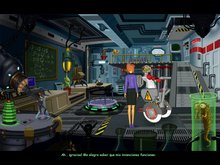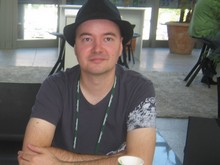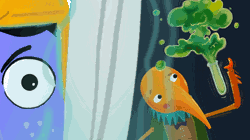- Interviews
- Agustin Cordes (Erster Teil) (Englisch)
Interviews
Agustin Cordes (Erster Teil) (Englisch)
Gesprächspartner: Ingmar Böke
Sprache: 
Vom:
26.08.2010
Über
Mit dem First-Person-Adventure Scratches wurde der argentinische Indie-Entwickler Agustin Cordes schlagartig einem großen Publikum bekannt. Nun ist Cordes mit seinem neuen Studio Senscape zurück und bereitet die Ankunft des Horror-Adventures Asylum vor.
Access the second part of the interview/Access the third part of the interview
Adventure-Treff.de: Hello Agustin, thanks a lot for doing this interview... especially, since a certain quarter final match of the World Cup isn’t that far behind us (not that Germany did it any better in their semi-final). Please introduce yourself to our readers.
Agustin Cordes: Oh don’t worry about the World Cup. I’ve gotten over that already. It’s just a game, and a silly one to boot... What’s so appealing about kicking a ball? Besides, I did have my revenge. Do you remember that stabbing headache you had a few weeks ago? That constant, throbbing pain in your forehead, like hundreds of little thin needles piercing through your brain... Remember how you cried uncontrollably at midnight, not able to find one moment of peace? Ever heard of voodoo dolls?
Anyway, I’m never sure how to define myself. As you know, I worked on the Scratches adventure a few years ago which happened to be very well received by critics and gamers alike. I still don’t know why, mind you... I love the craft of writing but I also enjoy programming - sometimes I can’t even decide which one I like the most! I definitely love to tell stories though and adventures are, by far, the best genre in games to do so.
A-T: Until this day, you’re not only a dedicated game developer but you also remained a dedicated gamer as well. Take us back to where it all started and give us an idea of how your passion for the adventure genre started and developed back then.
Agustin: It all started many moons ago when I was a ten year-old kid with too much time in his hands and an XT computer. There was a small but serviceable catalogue of games installed in that box: Jumpman, Space Invaders, Zaxxon, 3-Demon... Those were good games and I’m still very fond of them, but I clearly remember craving for another type of game, one that would allow me to explore and discover new things rather than shoot and run like a madman.
One day, a new game arrived and my hands trembled the instant I read its name: King’s Quest. It sounded exciting and glorious: the name alone had an epic feel to it, like it was something of truly utmost importance. Wild imagery was popping inside my head even before I inserted the disk (I really remember this). It may sound clichéd but, when the game started, it was a dream come true. There’s no other way to put it: I wanted a game like this before I knew it existed. The ability to explore an entire forest with treasures and strange creatures, to be rewarded for my intuition, not my reflexes, to care - for the first time ever - for the story behind the game. King’s Quest was a true revelation and I’m not exaggerating when I say that it shaped my childhood. To use another cliché, the rest is history. Next came Space Quest, Larry Laffer, Maniac Mansion, Monkey Island... Needless to say, I came to understand what a “girlfriend” meant when I was a much, much older person.

A-T: You’ve stated in the past that Dark Fall: The Journal has been quite an eye-opener for you. Would you say that this was the one experience that made you realize that you might be able to do something like that too... or were there any ambitions of becoming a game developer prior to your Dark Fall experience?
Agustin: Yes, the experience of playing Dark Fall for the first time was huge. By then I had this impression that the adventure genre was declining and Dark Fall was the game that brought back my faith in it. When I realised it was the work of one developer, I was blown away. Like you say, it was an eye-opener: I thought it can be done, someone did it, and he was successful at that! While I did have the intention of developing a game someday - and the Scratches story had been long lurking inside my head - you could say that it was Dark Fall what finally impelled me to fulfil those plans much faster. I can’t say what would have happened if I hadn’t played the right game at the right time.
We have become good friends with Jonathan Boakes, which was a really nice turn of events.
A-T: Please share some of the pleasure and pain you’ve encountered during the creation of your first game Scratches, which must have been quite a trip.
Agustin: Oh yes... I could write an entire book with the experiences of developing Scratches. It was painful because it was a very large project done by a very small team and we imposed ourselves very high goals in later stages -- it all began as a hobby actually, something we would do in our free time, but it slowly went to become a very serious project (so serious that I left a good job to do it). To give you a notion of how drastically things changed during the development, the house in Scratches was going to have only two floors at first and the presentation was going to be the well-known “slideshow” type as seen in Dark Fall. Then Vlad - ex-Cellar Of Rats - came aboard the project and it was him who suggested to make the switch to panoramic rotation. This basically meant redoing everything we had up to that point, but it totally was worth it.

All in all, it was a very difficult task, one that took much more time than we thought. Still, I wouldn’t change that for anything in the world as I’m very happy with the result. I can honestly say that the final game came out as I expected, and that was way more than I could ever ask for.
Of course, there were great moments as well. The best by far was the experience of being in touch with the early fans, people that were looking forward to Scratches. They supported us from the very beginning and I can’t thank them enough for that. Way before the game was even released, we already had an active community that participated each day in our forums. The fact that one day they would be playing Scratches and they would be around to tell us all about it was a notion almost impossible to grasp by me. It was a long and winding road alright, but a life-changing experience.
A-T: After the kudos you’ve gained with Scratches, Nucleosys was hired by the government of Buenos Aires to work on an educational adventure game named Risk Profile. Quite some of our readers may not be aware of this game, so it would be interesting to find out a little more about the whole project and in how far the development process differed from you experiences with Scratches.
Agustin: Unfortunately, Risk Profile was never translated to English or any language other than Spanish, so it’s understandable that so few people know about it. It was a wildly different kind of process to say the least. Scratches was a more intimate development where the final decisions were always up to us and, since we didn’t even have an office, it was a real lonely experience.
Risk Profile on the hand was a mammoth: we started being seven developers in total and in the end we were twice that much. Staff from the government itself took part in the development by suggesting educational aspects and puzzles. Even though we had plenty of freedom concerning the story and what would happen in a series of twelve chapters, the government insisted in following the entire process and made us redo many things, many times. I’m definitely OK with that because we knew beforehand that’s the way things were going to be, but in practice it was an absolute development hell.

For instance, preliminary parts of the game were tested in three different focus groups after the design document and overall structure of the game were long finished, and the reports imposed many unexpected changes. To put it bluntly, Risk Profile had to be developed in one year, in the end it was developed in year and a half, and in reality it should have been developed in two years. Picture over 50 interactive characters and over 80 different screens - many of them scrollable - in a dozen completely different locations to get and idea of the size of this game.
That said, Risk Profile was a smashing success and set a new standard for this type of educational adventures. It was the first time something like this was done in Argentina and (dare I say it) maybe even the entire world. Remember, this was an official project funded by our government: an educational adventure game to teach kids why (and how) they have to pay taxes. Sounds like a monumental train wreck on paper but, trust me, the resulting game was a hoot. Like I said before, I had plenty of freedom with the script and I managed to include some wild Pythonesque situations and jokes. A particularly neat feature is a couple of reporters that, after a set of missions, they gave players some closure by reporting the outcome of their actions. They gradually become increasingly weird, such as one of them experiencing a nervous breakdown or babbling incoherently, and at one point, the male reporter urges the citizens of Buenos Aires to seek shelter as a giant amorphous tentacled-being is ravaging the city. Sounds familiar?

A-T: In the last year you surprised the adventure world by announcing the end of Nucleosys. Anything you can tell us about how you and your former partner came up with the decision to close down Nucleosys?
Agustin: There’s not much to say really other than Nucleosys was a closed cycle. After the huge Risk Profile project, and all that implicated, I felt like there was a need for a fresh start. Being in a partnership it’s pretty much like being married: there are good and bad times, but sometimes daily life can get very tense, especially when creative work is by definition very demanding, and that makes people don’t get along anymore. Sad but true.
A-T: I guess that this is just the right moment to tell us more about your new studio Senscape, the other members, and where you’ve recruited them. In addition to that: A while ago you’ve stated that Asylum is gonna be nearly three times as large as Scratches and that you’ve been working on the game for a long time already. It seems like Senscape has been hiding in the cellar for quite a while, without anyone of us knowing of the unspeakable horrors you’ve been planning to unleash ever since then. Please give us an idea of when the actual development of the game started.
Agustin: Well, let’s see... Senscape as a company is young indeed but we’ve been working together for quite some time now. Besides me, there’s Pablo Forzolloza, Juan Caratino and Pablo Palomeque. They’ve all worked on Risk Profile and, even after such a jarring experience, they still wanted to keep making adventures, so go figure. A while after that project got finished, we banded together to make Asylum. We make a great team and became great friends in fact, so it’s a pleasure to work with them.

Both Pablo F. and Juan do everything related to the 3D objects and animations: we’re talking about modelling, texturing, lighting, camera work, etc. That said, Pablo has been focusing on the environments lately and Juan on the characters. To better understand what they do, the viral Bertrand sessions were mostly Juan’s work and the trailer Pablo’s. Their work is amazing and they instantly got the gist of the game. Many start-up projects like Senscape have a slow start until the team gets comfortable with the techniques and style, but these two guys made an instant connection with Asylum what the project represents.
Then we have the other Pablo (Palomeque) who is an extremely talented 2D and concept artist. He’s been doing everything from scenes and characters concepts to a huge matte painting that has been featured in the trailer. His work definitely rivals that of some major players in the movie industry and, incidentally, he has worked in movies from Francis Ford Coppola and Juan José Campanella (The Secret In Their Eyes). I can’t understand why he hasn’t become famous by now.

It would be unfair if I don’t mention either Daniel Pharos, who some of you know since he hails from Germany, as the musician doing the soundtrack for Asylum. Daniel is a newcomer to the band but he’s fully committed to the project, so much that I have the utmost confidence that his work will become legendary. Vlad K. is also around helping with another very secretive project, as is my brother Pablo Cordes. And no more Pablos, I swear!
So yes, we’ve been doing this for a while, lurking in the shadows as you say, and have been looking forward to announcing the game for many months. However, we wanted to do it right and that’s why we invested so much effort in the marketing and promotional materials. Many companies tend to simply issue a press release announcing that they are working on a certain game and I happen to strongly dislike that. To me, people must become in touch with the true essence of the project from the very beginning. An adventure game is a very intimate experience, more than any other type of game, and it can be a though process to become fully immersed in its own particular universe. That’s why I give so much importance to the preceding months before people gets to see the game: you are somehow playing from the very first moment you hear about it so that when you finally load the game, you are 100% prepared for the upcoming experience.

About the size, it’s huge - there’s no other way to say it. In plain technical terms, you get to explore nearly three times as many rooms as in Scratches. However, many rooms are immense halls. For instance, we treat the whole backyard of the Hanwell Mental Institute as a single room and, in “gameworld terms”, it practically has the same surface as the Blackwood mansion. So any way you want to look at it, Asylum is going to be large -- it will be two years since we are working on the building alone.
Aktuelle Artikel
![]()
Unterstützen
![]()
Adventure-Treff-Verein
IBAN: DE38 8306 5408 0004 7212 25
BIC: GENODEF1SLR
Bitte beachtet, dass wir leider keine steuerrechtlich anrechenbare Spendenquittungen ausstellen können.
Mit jedem Einkauf bei unseren Partnern unterstützt ihr die Arbeit des Adventure-Treff e.V.












